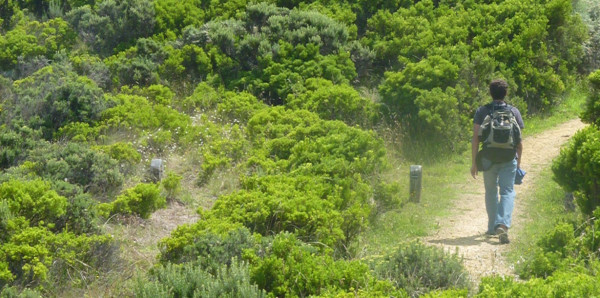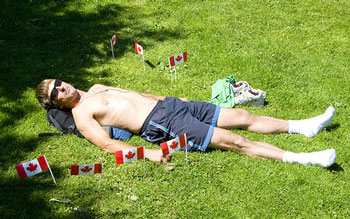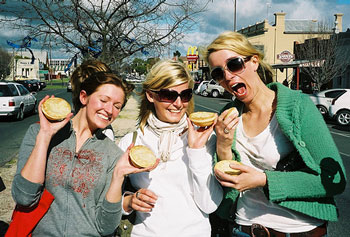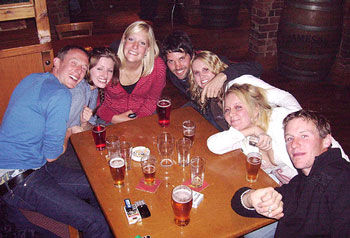(original article here)
 |
| Chef Gastón Acurio hosts popular TV cooking shows, writes cookbooks, pens opinion pieces for newspapers and is featured in documentaries. Max Cabello for The Wall Street Journal |
LIMA, Peru—In Lima, South America’s culinary capital, Gastón Acurio is like no other chef: He has turned guinea pig into a tender delicacy and is credited with introducing ceviche, the bite-sized raw fish marinated in lime juice, into the world of fine dining.
With 44 restaurants in 13 countries, he has taken Peruvian cuisine global. So it wasn’t out of the ordinary when Mario Vargas Llosa, Peru’s Nobel Prize-winning author, quipped at a recent political seminar that Mr. Acurio would make a fine presidential candidate.
The 46-year-old Mr. Acurio says he is more interested in using food to rebrand his country. “In the end I’m not going to become a politician,” said Mr. Acurio, who wears his hair long and feverishly touts Peruvian food on television and in food fairs. “A chef can do a lot of good things for his country without falling into the vanity of believing that he is the country’s savior.”
Mr. Acurio, who opened his first restaurant 20 years ago, hosts popular TV cooking shows, writes cookbooks, pens opinion pieces for newspapers and is featured in documentaries. As a chef, he is Peru’s answer to Jamie Oliver and Anthony Bourdain.
 |
| Mr. Acurio with participants in the Mistura International Gastronomy Fair in Lima in September. Max Cabello |
But he also is a businessman, and in Peru he is in a class with some of the country’s top banking and mining executives—underscoring the economic power of cuisine.
The number of restaurants in Peru has more than doubled to 80,000 in the past 14 years, as the country clocked the continent’s fasted economic growth, said the Peruvian Society of Gastronomy, a group that organizes an annual 10-day food festival here. The restaurant sector grew 6% last year and 9% in 2012, an expansion clearly evident in the long lines of locals and food tourists snaking around this capital’s most popular restaurants.
In Mr. Acurio’s case, what started out as a cozy restaurant on a quiet street is now a business empire. Mr. Acurio’s holding company, Acurio Restaurantes, doesn’t disclose earnings figures. But it attracts investors like the Dubai-based Abraaj Group, which manages $7.5 billion in assets in emerging markets and in 2012 bought a minority stake in Acurio Restaurantes.
“An IPO is a possibility,” said Hector Martinez, managing direct at Abraaj. “If it happens, it may occur in three to four years when we get the size to go public.”
Mr. Acurio’s life in the kitchen wasn’t what his parents expected. When he was 8 years old, his father, a senator, encouraged him to read Adam Smith’s “The Wealth of Nations” and works by the philosopher Karl Popper. In the late 1980s he was sent to study law in Spain.
 |
| Mr. Acurio serves a dish at the fair. |
But Mr. Acurio said he ditched it all for the fast-paced heat of a kitchen. He dropped out of law school without telling his family, and moved to Paris to study cooking at Le Cordon Bleu. There, he met his German-born wife, Astrid Gutsche.
“It was very difficult to tell your parents, who dreamed you would become an engineer, lawyer or doctor, that you were going to be a chef,” Mr. Acurio said. “The chef, who has a role, a voice and influence in society today, was at that time a more obscure figure.”
Mr. Acurio and Ms. Gutsche, a pastry chef, moved back to Peru in the early 1990s and opened their first restaurant, Astrid y Gaston, in Lima’s Miraflores neighborhood. The enterprise was a risky one. Peru was just recovering from years of economic turmoil and still locked in conflict with Maoist guerrillas.
 |
| The 46-year-old Mr. Acurio says he is more interested in using food than politics to rebrand his country. |
As it turned out, Mr. Acurio’s restaurant came at a turning point for Peru. In the last decade, in fact, the poverty rate has fallen to 24% from almost 60%, and foreign investment has flowed into mining and other sectors. A whole new consumer class has been born.
“The Peruvian gastronomic revolution has a lot to do with the economic development of the nation,” said Ignacio Medina, food critic for the magazine, Somos, “and the consolidation of the new middle classes in Lima and other large cities.”
Before Mr. Acurio’s venture took off, French restaurants monopolized Lima’s fine-dining scene. Today, local chefs are inspired by the indigenous, Spanish, African and Asian influences that simmered together over 500 years. Add in Peru’s rich diversity in ingredients—home to many spices, myriad species of fish, hundreds of potato varieties—and the country had the components for a culinary revolution.
Food critics and restaurant owners say it was Mr. Acurio who took unsung dishes and made them the focal point for a nation starting to burst with confidence.
“Without a doubt, food was at that moment a major flag bearer for the recovery in our national pride,” said Mr. Acurio, who in March relocated Astrid y Gaston to a colonial-era mansion after a $6 million renovation of the building, which still features 300-year-old wooden floors and a small chapel. “We had a very important gastronomic legacy, but like everything else, it was simply hidden.”
Take ceviche. It originated from pre-Hispanic indigenous communities living on Peru’s northern coast, with Spaniards later adding lime juice and red onions. Then there is Lomo saltado, a beef stir fry created by Cantonese immigrants. And African slaves perfected Anticuchos, the skewers of tender beef heart. Other dishes rely on everything from sea snails to cow stomachs and guinea pigs, complete with whiskers and teeth.
With all the interest in food, demand for chefs has grown, leading to the growth of culinary schools.
At the academy Mr. Acurio runs, in a poor district north of Lima called Pachacutec, about 20 students were busy peeling shrimp and sautéing vegetables on a recent day as they learned the art of preparing Chifa, dishes with a heavy Chinese influence. The school, which Mr. Acurio opened in 2007 for students from low-income homes, receives about 350 applications a year, admitting only about 25 students per semester.
Some of Mr. Acurio’s protégés have even left their mark far from Lima. In London, Virgilio Martinez, a 36-year-old chef, opened one of the first Peruvian restaurants in that city in 2012. The restaurant, called Lima, was the first Peruvian establishment to earn a Michelin star.
A few years ago there were only a handful of Peruvian restaurants in Miami, but the Peru’s consulate says there are now almost 100, including Mr. Acurio’s, recently opened La Mar cevichería in the five-star Mandarin Oriental hotel.
Not everything has been a success. In Manhattan, Mr. Acurio’s La Mar restaurant failed. But Mr. Acurio still plans to open a similar restaurant in Buenos Aires soon and others in London and Dubai over the next year. For him, the success of these restaurants—his and those of other Peruvian chefs overseas—is a symbol of the growing clout of Peruvian food.
“It is no longer just a Peruvian chef in his Peruvian restaurant,” he said, “but rather Peruvian culture is influencing French restaurants.”
Indeed, the influence of Peruvian food has even rubbed off on world-renowned chefs, like Alain Ducasse. He has made it a point to serve ceviche at his Rech seafood restaurant in Paris.
Said Mr. Medina, the food critic, “The talent of Gastón Acurio has been to turn the best chefs in the world into champions of Peruvian cooking.”
Write to Ryan Dube at ryan.dube@dowjones.com and Robert Kozak atrobert.kozak@wsj.com






 You will hear this backpacker immediately upon entering the hostel. Loud, enthusiastic and friendly, the American Backpacker either travels in large groups of young college girls or guys, or, if a little bit older, travels hans solo. The delightful college girl American Backpacker wears pajamas during the day and tight bright clothing at night, and is never without numerous layers of make up and hairspray, and the college boy American Backpacker has usually found their way to Central or South America on a cheap flight from Miami and are ready for a week of drinking and partying.
You will hear this backpacker immediately upon entering the hostel. Loud, enthusiastic and friendly, the American Backpacker either travels in large groups of young college girls or guys, or, if a little bit older, travels hans solo. The delightful college girl American Backpacker wears pajamas during the day and tight bright clothing at night, and is never without numerous layers of make up and hairspray, and the college boy American Backpacker has usually found their way to Central or South America on a cheap flight from Miami and are ready for a week of drinking and partying. Can spot these a mile away due to the prevalence of Canadian flags sewn on to their backpack and the ‘ey’ at the end of every sentence (“Canada, ey”).
Can spot these a mile away due to the prevalence of Canadian flags sewn on to their backpack and the ‘ey’ at the end of every sentence (“Canada, ey”). The English Backpacker travels in a massive group with other suntanned/burnt/fake-tan orange English Backpackers. Friendly but often spends time whinging on a hostel balcony.
The English Backpacker travels in a massive group with other suntanned/burnt/fake-tan orange English Backpackers. Friendly but often spends time whinging on a hostel balcony. Friendly, adventurous and laid back, but can be annoyingly loud and is the centre of every party once drunk. Always the one that does the stupid dares.
Friendly, adventurous and laid back, but can be annoyingly loud and is the centre of every party once drunk. Always the one that does the stupid dares. Not to be confused with the English Backpacker, the Irish Backpacker is usually a little older and travels in pairs or by themselves. Like a homing pigeon, this gem of a backpacker always manages to find the best deals on a pint at any time of the day and is friendly and inclusive of all other travelers.
Not to be confused with the English Backpacker, the Irish Backpacker is usually a little older and travels in pairs or by themselves. Like a homing pigeon, this gem of a backpacker always manages to find the best deals on a pint at any time of the day and is friendly and inclusive of all other travelers.










